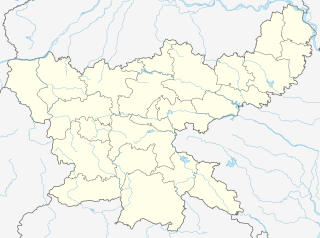
Gawan block is a community development block that forms an administrative division in the Khuri Mahua subdivision of the Giridih district in the Indian state of Jharkhand.

Tisri is a community development block that forms an administrative division in the Khori Mahuwa subdivision of the Giridih district in the Indian state of Jharkhand.

Jamua is a community development block that forms an administrative division in the Khori Mahuwa subdivision of the Giridih district in the Indian state of Jharkhand.

Koderma is a community development block that forms an administrative division in the Koderma subdivision of the Koderma district, Jharkhand state, India.

Domchanch is a community development block that forms an administrative division in the Koderma subdivision of the Koderma district, Jharkhand state, India.

Jainagar is a community development block that forms an administrative division in the Koderma subdivision of the Koderma district, Jharkhand state, India.

Chandwara is a community development block that forms an administrative division in the Koderma subdivision of the Koderma district, Jharkhand state, India.

Markacho is a community development block that forms an administrative division in the Koderma subdivision of the Koderma district, Jharkhand state, India.

Jamua is a village in the Jamua CD block in the Khori Mahuwa subdivision of the Giridih district in the Indian state of Jharkhand.

Telodih is a census town in the Giridih CD block in the Giridih Sadar subdivision of the Giridih district in the Indian state of Jharkhand.

Sirsia is a census town in the Giridih CD block in the Giridih Sadar subdivision of the Giridih district in the Indian state of Jharkhand.

Domchanch is a census town in the Domchanch CD block in the Koderma subdivision of the Koderma district in the Indian state of Jharkhand.

Markacho is a village and gram panchayat in the Markacho CD block in the Koderma subdivision of the Koderma district in the Indian state of Jharkhand.

Chandwara is a village and gram panchayat in the Chandwara CD block in the Koderma subdivision of the Koderma district in the Indian state of Jharkhand.

Jainagar is a village and gram panchayat in the Jainagar CD block in the Koderma subdivision of the Koderma district in the Indian state of Jharkhand.

Satgawan is a village in the Satgawan CD block in the Koderma subdivision of the Koderma district in the Indian state of Jharkhand.

Dhab is a village in the Domchanch CD block in the Koderma subdivision of the Koderma district in the Indian state of Jharkhand.

Nawalsahi is a village in the Domchanch CD block in the Koderma subdivision of the Koderma district in the Indian state of Jharkhand.

Nawadih is a village and a gram panchayat in the Markacho CD block in the Koderma subdivision of the Koderma district in the Indian state of Jharkhand.

Bekobar is a census town in the Koderma CD block in the Koderma subdivision of the Koderma district in the Indian state of Jharkhand.


